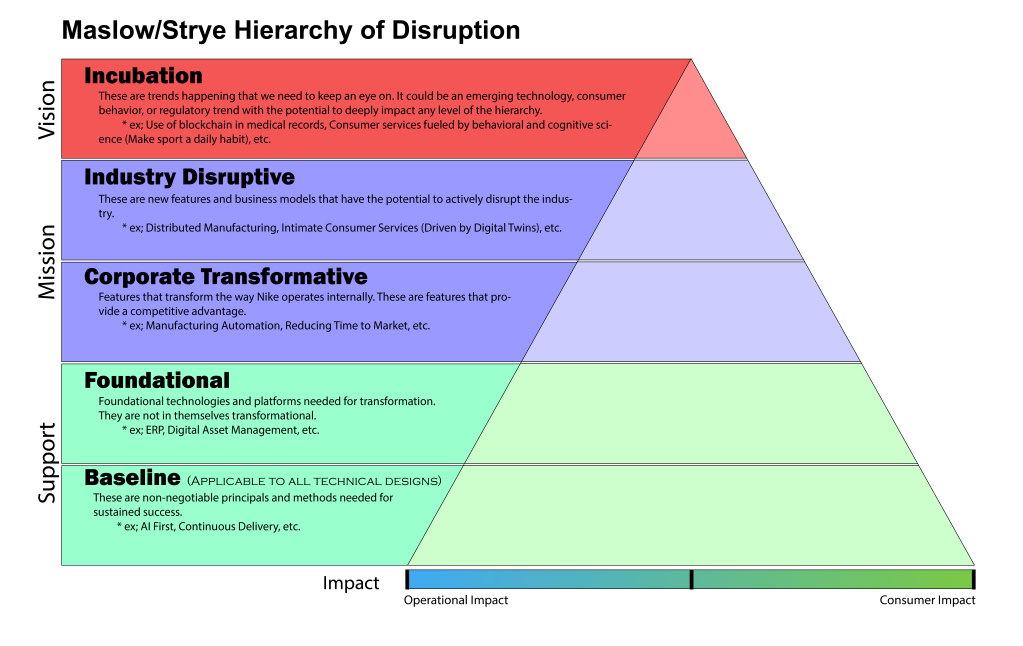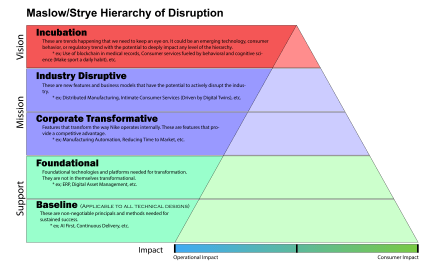I wanted to do an introduction to the Maslow/Strye Hierarchy of Disruption, or “HoD” for short. It’s something I’ve been working on for a while and it seemed time to share. Feel free to use it. All I ask is a nod of acknowledgement.

Some days it seems that technology is evolving faster than we can track. It’s undeniable that over the last decade we’ve seen innovations in technology change the way customers act and respond. From higher consumer expectations in shipping to the way we interact socially and even concerns about digital privacy. These changes in turn have lead to even further demand for innovation and faster change in order to keep pace with expectations. This cycle has almost everyone in the midst of a digital transformation, and it can be difficult to impossible to keep your head above the rising tide of new technologies and buzzwords. Let alone understand how they impact the enterprise.
With this in mind I created the Hierarchy of Disruption to help with three primary things. 1) It entices you to think critically about the technology, platforms, and solutions as applied to a business problem or initiative. What we’ll call the “context.”” 2) It lets you clearly outline the links between related technologies. 3) Frames the context in a way that lets you distinguish between useful innovations and hype-cycle technologies.
The end benefit is a model that provides a focus on impact and needed investment. Not just at the edge of business development, but through the full support chain down to foundational components and fundamental principals. When incorporated into solution strategies and extended into architecture road-maps the Hierarchy of Disruption becomes a powerful tool to guide, inspire, and focus efforts.
Let’s dive a bit deeper to see how it works.
The HoD is made of five layers combined into three sections; Support, Mission, and Vision. From bottom to top we start with the Support section. The first layer is the Baseline layer.

The Baseline layer consists of those non-negotiable practices and principals across both the project and the enterprise. Note that we don’t need to list out every enterprise principal here. Focus on the most relevant practices and principals that impact the context being modeled.

The other layer in Support is Foundational. These are primarily platforms and technologies needed to deliver at a higher level. It can be tempting to elevate a component in the foundational layer up the pyramid because of large scope, but that defeats the point. To illustrate this I’ll use an ERP platform as an example. ERP upgrades are often multi-year projects with broad scope. They touch large swaths of the enterprise and cost — let’s just say, “a lot.” It’s a large scale and important, perhaps even critical, modernization effort that needs to be undertaken. But, transformative? I don’t think so. Now modernization may be needed to unlock other efforts at higher layers, but separate those items out. The point here is to show dependencies and give an honest assessment.
Now if you’re introducing the concept of an ERP into your enterprise for the first time, then by all means elevate the platform to the Corporate Transformative layer. Then over time allow it to naturally shift down in to the Foundational layer.

The next section is Mission, and the first level is Corporate Transformative. These are items that transform how you run the business within the context of the model. This last bit is important. While HoDs can be layered on top of each other to provide an aggregate view, it is important that each individual HoD stay true to it’s context. This allows leadership to weight different contexts to get a more refined view of priorities.
For example; let’s say we have a context regarding Digital Asset Management (DAM). In that context we have an innovative search component that rises to the level of Corporate Transformative. We also have a separate contextual model regarding Digital Marketing. In this context we have DAM listed as Foundational. If the search innovation from the DAM context is not critical to Digital Marketing, then we may not even call it out as being separate from the DAM. However; if the new search innovation is key to the transformation of our Digital Marketing context then we will call it out separately and elevate it to the Corporate Transformative level in our digital marketing context. When we aggregate these context together we’d be able to calculate an impact score for our search innovation. In the first scenario the score would be lower, in the second higher.

Next in the Mission section is Industry Disruptive. These are game changers with a more broad based impact external to your brand. It could be something that changes consumer expectations, forces competitors to scramble to catch-up, or that creates/redefines an aspect of your industry. Modern examples range from the iPhone on the product side to free two day shipping on the services side. Both changed consumer wants and expectations in a disruptive way. As an aside, Henry Ford’s assembly line is an example that starts as being Corporate Transformative and quickly moves into the Industry Disruptive layer. Showing that, while downward movement is the norm, items can move up the stack as well.

This takes us to the final section Vision and the top layer Incubation. These are technologies and trends that may have a big impact and we need to keep an eye on them. They may not be developed enough to include or simply require more research. Either way these are things that need to be monitored to determine if they are relevant and how they can be included.
Incubation sits at the top of the pyramid for a few reasons. One, it serves as the fulcrum of disruptive thinking and may have ripple effects all the way down. Two, these items look farther to the future and should serve as inspirations. They may start as hazy outlines, taking shape over time. Going from the silhouette on the horizon to the clear picture before us.
All of these layers working in conjunction create a living contextual model. When these contextual models are combined they create an aggregate model. A lodestar that highlights dependencies and allows us to measure impact. That plants the seeds of inspiration while illuminating the connectedness of the enterprise.
That’s all for now. I hope you enjoyed this brief introduction to the Hierarchy of Disruption. I hope you found the information here valuable. I’ll planning on putting together more information and creating additional assets to go along with it.
Until next time. Be happy. Be safe.
Cheers.
